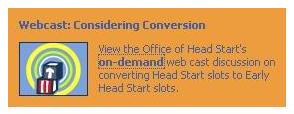Hard Realities for Early Head Start
Blog Post
Feb. 5, 2009
As the Senate debates whether to cut some Head Start funding from the stimulus package, let's zoom in on Early Head Start for a minute. Early Head Start has been shown to give children a significant boost in cognitive and social skills, according to solid, scientific research. Yet the program serves only 62,000 children nationwide.
Those small numbers are one reason why President Obama has called for quadrupling the program. It’s also part of why, in late 2007, lawmakers added a new provision to the laws governing Head Start. The provision gives Head Start centers, which typically serve 4-year-olds, the ability to transform themselves into Early Head Start programs, which provide pre-natal, infant and toddler services.
But there is one hitch: no federal dollars come with this new flexibility. If a center wants to open an Early Head Start program, which often includes home visits plus center-based care, it will have to shut down classrooms for its preschoolers and serve fewer children unless it finds outside funding.

It's not great television, but it makes a compelling case for why Early Head Start will not be able to expand in any significant way without additional financial support. To convert to an Early Head Start program, administrators will have to cut enrollment for preschoolers, the video tells us. And once administrators open their Early Head Start programs, they will probably be serving fewer children than they did before. That's because quality programs for infants and toddlers require a lower child-to-instructor ratio. Without the money to hire additional teachers, centers will have to cut back on the number of young children they serve.
Here’s Craig Turner, director of policy and budget for the Office of Head Start, explaining what administrators will have to do to gain approval for conversion:
“You will have to propose enrollment reductions of discrete classrooms of 17 to 20 children,” he said. “You must be willing to fund a meaningful reduction in size in your Head Start programs.”
“You can serve two Early Head Start children for every three Head Start children," he added later. "Unless you are bringing outside resources, this will result in a reduction in children.”
Sounds a little like robbing Peter to pay Paul, don't you think? Given these limitations, will Head Start centers even attempt a conversion? In some places, yes, preschool enrollments may be declining as children enroll in state-based pre-K programs -- and perhaps in those cases, the conversion will still make sense. Yet in this economy, with more people out of work, the number of families eligible for Head Start is more likely to go up than down. Before debate started this week, the stimulus package in both the House and Senate versions, included a $1 billion boost to the program. We’ve argued that early childhood programs need more than just a temporary infusion of cash; they need sustainable support that lasts more than 2 years. Whatever the form, more funding is vital for a program that has, in its first 15 years, demonstrated considerable success.